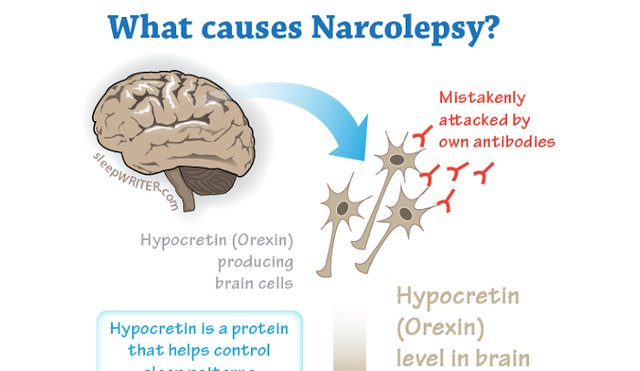NARCOLEPSY - Easy Sleeper.
WHAT IS NARCOLEPSY?
Narcolepsy is a lifelong disorder of the nervous system which causes abnormal sleep that could affect a person’s quality of life.This very rare condition which has been estimated to affect about one (1) out of every two thousand (2,000) people, and its symptoms usually begin between the ages of ten (10) and twenty five (25) years, but usually not recognized right away.

Upsurge of some significant daytime drowsiness and also sleep attacks are very much likely for one having this condition. In most cases, it also causes temporary and unexpected loss of muscle control, commonly known as cataplexy. Although narcolepsy is not a deadly disease on its own, but some episodes can lead to some life-threatening situations such as accidents, injuries etc.
Basically there are two types of narcolepsy which are: Type 1 and Type 2 narcolepsy
While Type 1 is narcolepsy with cataplexy, Type 2 is narcolepsy without cataplexy. Type 1 appears to be the most common. Cataplexy, especially in children, is often mistaken for as seizure activities.
An individual's normal sleep occurs in five (5) stages and in cycles. The sleep cycle begins and we move from light sleep to deep sleep, then into regulated eye movement (REM) sleep, while dreaming, then muscle paralysis occur. It takes about seventy (70) to ninety (90) minutes for one to reach the first cycle of regulated eye movement sleep. The longer time we stay asleep, the more time we spend in regulated eye movement sleep, and the less time we spend in deep sleep. Scientists believe adequate regulated eye movement sleep is necessary for one's survival. It's a different case for people living with narcolepsy as they can suddenly fall asleep, lose muscle tone, and begin to dream. This happens irrespective of what they’re doing or what time of day it is. When this happens, their regulated eye movement sleep occurs spontaneously and inappropriately.
WHAT CAUSES NARCOLEPSY?

The precise cause of narcolepsy is still unknown, but it has been discovered that most persons with narcolepsy and cataplexy have a reduced or decreased amount of a particular brain protein called hypocretin. The basic function of hypocretin is regulating the sleep-wake cycles. Thus, scientists come in agreement to the thought that the reduced level of hypocretin might be due to a number of factors but a gene mutation has been identified which causes low levels of hypocretin. It is a general accepted belief amongst medical practioners that this hereditary deficiency as well as an immune system which attacks healthy cells, contributes immensely to narcolepsy. However, factors such as infections, stress, exposure to toxins also may constitute it's causes.
SYMPTOMS OF NARCOLEPSY
A good number of sleep experts have linked the symptoms of narcolepsy significance to poorly regulated rapid eye movement (REM) sleep. How intensely and how often the symptoms occur varies. The most common symptoms of narcolepsy includes:
• Sleep paralysis:
The inability to move or speak while falling asleep, sleeping, or waking, with episodes that last only a few minutes. This symptom takes after the paralysis seen during regulated eye movement sleep. However it doesn't affect the ability to breathe or eye movements. It could even occur in people who don’t have narcolepsy.
• Significant daytime sleepiness:
Excessive or a significant amount of daytime drowsiness is usually the first symptom of narcolepsy and it makes it very difficult for one with narcolepsy to function properly during the day.
• Hallucinations when falling asleep:
Hallucinations also occur very much in people with narcolepsy, due to the fact that dreaming is typically part of regulated eye movement sleep. If you dream when you are partially awake, then they may seem much like reality.
• Cataplexy:
The sudden temporary loss of one's muscle tone, usually triggered by intense emotions such as laughter, anger, excitement and fear is called cataplaexy. The frequency of the occurrence of cataplexy varies from person to persons, as some people may have it several times per day while some their people may experience it a few times per year.
Narcolepsy has also been associated with other sleep disorders, such as insomnia, obstructive sleep apnea, restless legs syndrome.

TREATMENT FOR NARCOLEPSY
Narcolepsy still has no cure, as the condition lasts a lifetime. The reason for treatment is to regulate the symptoms and also improve day-time functioning. Lifestyle adjustments as well as avoiding hazardous activities are all very important in treating this condition.
Treatment for narcoleptic symptoms are several but the majority ones includes:
• Serotonin-norepinephrine reuptake inhibitors such as venlafaxine (Effexor)
• Tricyclic antidepressants
• Stimulants such as armodafinil (Nuvigil), modifinil (Provigil) and methylphenidate (Ritalin)
• Selective serotonin reuptake inhibitors (SSRIs), such as fluoxetine (Prozac)
The above mentioned medications could have have some serious and unpleasant side effects, such dry mouth, urinary retention and as constipation.
For everyone living with narcolepsy, it could be very challenging as well as stressful to have so much episodes of excessive sleepiness, which makes it also possible to injure oneself or others a able to manage the condition and live a healthy life.